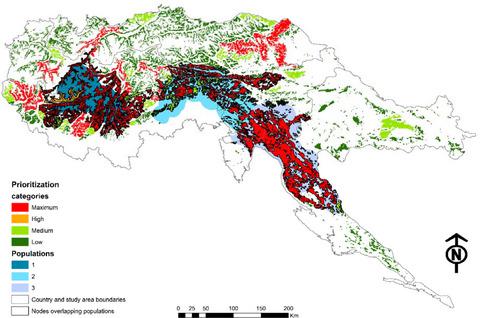当前位置:
X-MOL 学术
›
Anim. Conserv.
›
论文详情
Our official English website, www.x-mol.net, welcomes your feedback! (Note: you will need to create a separate account there.)
Context‐dependent behaviour and connectivity of recolonizing brown bear populations identify transboundary conservation challenges in Central Europe
Animal Conservation ( IF 3.4 ) Pub Date : 2020-07-18 , DOI: 10.1111/acv.12624 M. R. Recio 1, 2 , F. Knauer 3 , A. Molinari‐Jobin 4 , Đ. Huber 5 , S. Filacorda 6 , K. Jerina 2
Animal Conservation ( IF 3.4 ) Pub Date : 2020-07-18 , DOI: 10.1111/acv.12624 M. R. Recio 1, 2 , F. Knauer 3 , A. Molinari‐Jobin 4 , Đ. Huber 5 , S. Filacorda 6 , K. Jerina 2
Affiliation

|
Following historical restrictions to isolated and patchy populations, large carnivores like the brown bear Ursus arctos are recolonizing areas of their historical range in Europe. This process is of particular interest in the Alps and the Dinaric Mountains in Central Europe, the largest mountain range in the continent and of transboundary conservation interest. To assist policies focused on the expansion of bears in this region, we conducted habitat selection analyses accounting for different behaviour between three populations (Trentino, pre‐Alps and Dinaric) where bears have adapted to different intensities of human persecution. We then identified the landscape connectivity between these fragmented populations that could provide viable habitat and stepping‐stone patches for recolonization. To handle individual and population differences in space‐use, we modelled habitat selection per population from an individual‐level and integrated results into a multi‐population model using scale‐integrated resource selection functions. We then calculated connectivity indices per patch and the contribution of various countries involved in bear management in the region to enhancing connectivity. Bears mostly selected forests across all populations while preferences for other variables differed among populations and across scales. Bears in the highly humanized habitats of the Trentino selected the most intricate topography, where they could more easily find refuge. Suitable but fragmented habitat patches were common all over the study area with the most suitable habitat in the pre‐Alpine and Dinaric populations. However, the Trentino and pre‐Alp included the patches of maximum/medium priority as stepping‐stones to connect these populations. Transboundary initiatives for the conservation of existing habitat and the facilitation of connectivity are required to promote current bear expansion and reduce conflicts with humans. Our framework provides insight into the adaptive behaviour of large carnivores in human‐dominated landscapes in a conservation context.
中文翻译:

依赖环境的行为和重新定居的棕熊种群的连通性确定了中欧的越境保护挑战
在历史上限制了孤立和零散的种群之后,大型食肉动物如棕熊熊熊(Ursus arctos)正在重新殖民其在欧洲的历史范围。在中欧的阿尔卑斯山和迪纳里克山脉(该大陆最大的山脉)和跨界保护意义上,这一过程尤为重要。为了协助专注于该地区熊熊扩张的政策,我们进行了栖息地选择分析,考虑了三种种群(特伦蒂诺,阿尔卑斯山前和迪纳里克)之间的行为差异,其中熊适应了不同程度的人类迫害。然后,我们确定了这些零散的种群之间的景观连通性,它们可以提供可行的栖息地和重新定居的垫脚石。为了处理空间使用中的个人差异和人口差异,我们从个体水平对每个人口的栖息地选择进行建模,并使用规模整合的资源选择功能将结果整合到多人口模型中。然后,我们计算了每个补丁的连接性指数,以及该地区参与熊管理的各个国家对增强连接性的贡献。在所有种群中,熊大多是选定的森林,而其他变量的偏好在种群之间和规模上各不相同。特伦蒂诺(Trentino)高度人性化的栖息地中的熊选择了最复杂的地形,可以更轻松地找到避难所。在整个研究区域内,合适但零散的栖息地斑块普遍存在,而最合适的栖息地在前阿尔卑斯山和迪纳里克地区。然而,特伦蒂诺(Trentino)和阿尔卑斯山(Alp)包含了最高/中优先级的补丁,作为连接这些人群的垫脚石。需要采取跨界举措保护现有生境并促进连通性,以促进当前的熊类扩张并减少与人类的冲突。我们的框架深入了解了大型食肉动物在自然保护环境中在人类主导的景观中的适应行为。
更新日期:2020-07-18
中文翻译:

依赖环境的行为和重新定居的棕熊种群的连通性确定了中欧的越境保护挑战
在历史上限制了孤立和零散的种群之后,大型食肉动物如棕熊熊熊(Ursus arctos)正在重新殖民其在欧洲的历史范围。在中欧的阿尔卑斯山和迪纳里克山脉(该大陆最大的山脉)和跨界保护意义上,这一过程尤为重要。为了协助专注于该地区熊熊扩张的政策,我们进行了栖息地选择分析,考虑了三种种群(特伦蒂诺,阿尔卑斯山前和迪纳里克)之间的行为差异,其中熊适应了不同程度的人类迫害。然后,我们确定了这些零散的种群之间的景观连通性,它们可以提供可行的栖息地和重新定居的垫脚石。为了处理空间使用中的个人差异和人口差异,我们从个体水平对每个人口的栖息地选择进行建模,并使用规模整合的资源选择功能将结果整合到多人口模型中。然后,我们计算了每个补丁的连接性指数,以及该地区参与熊管理的各个国家对增强连接性的贡献。在所有种群中,熊大多是选定的森林,而其他变量的偏好在种群之间和规模上各不相同。特伦蒂诺(Trentino)高度人性化的栖息地中的熊选择了最复杂的地形,可以更轻松地找到避难所。在整个研究区域内,合适但零散的栖息地斑块普遍存在,而最合适的栖息地在前阿尔卑斯山和迪纳里克地区。然而,特伦蒂诺(Trentino)和阿尔卑斯山(Alp)包含了最高/中优先级的补丁,作为连接这些人群的垫脚石。需要采取跨界举措保护现有生境并促进连通性,以促进当前的熊类扩张并减少与人类的冲突。我们的框架深入了解了大型食肉动物在自然保护环境中在人类主导的景观中的适应行为。



























 京公网安备 11010802027423号
京公网安备 11010802027423号